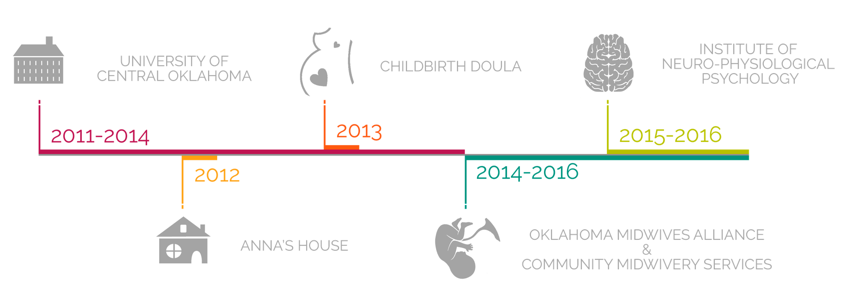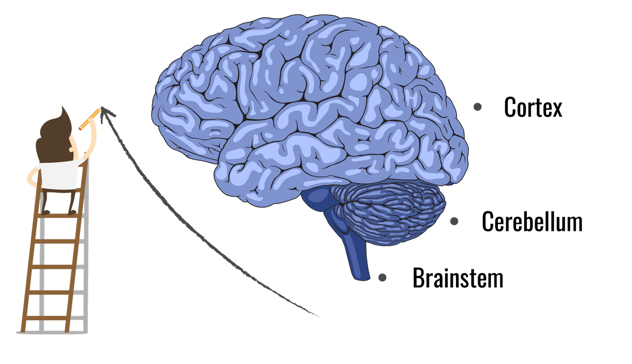Emily: I have been writing this course for a little bit, and I have had a great time doing it. I hope that you guys will all enjoy it as much as I have. The course I am teaching today is all about normal development, specifically normal brain development, and I think that this is a really important topic for anybody who works with children or anybody who works with individuals who have developmental delays. If you are working with somebody who has dysfunction with the way that they developed, I think it is important to understand the way that things should have gone. It is easier to understand what happens when things do not go smoothly and how you can better serve individuals in that capacity.
My Background

Figure 1. My background.
I have a bachelor's degree in psychology, a certified midwife's assistant, and I have a postgraduate degree in neurodevelopmental delay therapy. I knew that I wanted to be a neurodevelopmental delay therapist, or NDD therapist since I was a pretty young teenager. I had a cousin who had a lot of different developmental delays, and he had several different diagnoses. He was on many medications and went to several different therapists. NDD therapy was the thing that made the most difference for him. As a teenager, I got to witness his success with the program, and I knew that I wanted to be able to offer families the same thing.
I went to college at UCO, the University of Central Oklahoma, where I got Bachelor's degree, and while I was there, I took a summer off and went to intern at a place called Anna's house. Anna is an NDD therapist in Colorado. She is the one that helped my cousin so much, and while I was there interning with her, her pregnant daughter was working there. She was planning on using a midwife for her prenatal care and her delivery. I knew a little bit about midwifery care as my mother had used a midwife with me. It is not really the norm here in the U.S. so I had a lot of questions. I was really curious about it, and one of the things that they explained to me was that pregnancy and birth play a really huge role in brain development. The type of holistic and preventive care that midwives provide helps to prevent a lot of the different neurological delays and problems that Anna was seeing in her practice. During my time in college, I had taken several developmental psychology classes, and of course, we had spent quite a bit of time talking about pregnancy how important that was for brain development, but it was not really until that internship that I realized just how important labor and birth are to brain development as well.
I left that internship really eager to learn more, and I decided to become a childbirth doula. A doula is somebody who provides physical and emotional support to women during labor. This involves a lot of comfort measures and coaching but not as much on the medical side of things. I worked and did that during my last year of college. Once I graduated, I wanted to learn more about the medical side of things, and how birth has an impact on the brain and on development.
Once I graduated from college, I enrolled in the Oklahoma Midwives Alliance for a midwife assistant course, and I also started a clinical apprenticeship at Community Midwifery Services, which is a birth center here in Oklahoma. A year later I was accepted into the postgraduate program for neurodevelopmental delay therapy at the Institute of Neuro Physiological Psychology. Once I graduated from there, I opened a practice called Early Roots. I work with kids who have very specific types of developmental delays.
Early Brain Development
When most people talk about brain development, they tend to focus on infancy and early childhood when the brain is going through so many different incredible changes. There are many courses and books out there about brain development during early childhood. and I recommend it if it is something that you are interested in, but for the sake of this course, I want to focus on the development and the changes that happen during pregnancy, during birth, and during early infancy. This period of brain development is often overlooked, particularly labor and birth.
I work with a wide variety of children, but all of them have some sort of dysfunction that can be traced back to this early period of brain development. The brain development that is happening during this early time, from conception through the first year, provides the foundation for the rest of brain development. Before we get into any specifics, I want to talk to you about a couple of general concepts about brain development. There are two general concepts that I want you to understand.
1st General Concept
The first one is that the brain develops from the bottom up as shown in Figure 2. This happens both physically and functionally, and you can see this pretty easily in fetal development.

Figure 2. Concept 1 of brain development.
The first part of the nervous system to form is the spinal cord, the brainstem, the cerebellum, and then the cortex. Thus, at birth, the baby's brain stem is the most mature. It is not fully mature, but it is really close. It regulates most of their functioning, and as they develop, the rest of their brain will begin to mature in this order, from the bottom to top. The top part of the brain, the prefrontal cortex, is not fully mature until people are in their early 20's. What I want you to keep in mind is that with each of these sections the brain is responsible for more and more advanced functions, and they build on one another. I like to use the analogy of a house where the brainstem provides the foundation, the cerebellum is the walls, and the cortex is the roof. Each of these sections of the brain needs the support of the lower sections in order to function properly. So when you have somebody who has some sort of developmental delay going on, this is something that is really important to keep in mind. All of the kids that I work with have some sort of problem or symptom related to the mid and/or upper brain function. What I see in these children are a poor academic achievement, poor emotion regulation, poor impulse control, poor social skills, and so on, but their dysfunction does not start there. Their dysfunction starts much lower at the brainstem level, and I focus heavily on the brainstem and early brain development because it provides the foundation for all other skills.
2nd General Concept
The second kind of general concept about brain development is that the brain develops through use, through movement, and through interaction with the environment. It is our experience of the world that shapes both our brain and our body, and this type of interaction with the environment are critical for proper development of not just your brain but also your body systems as well. I will get into more detail with this later. It is really important to keep in mind that the brain and the body are completely connected and interdependent. We often think of the two separately, but they are not separate. They grow and develop together. This is easy to understand this if you think about the structure of the nervous system and how the brain connects to the spinal cord which connects all nerves that travel throughout the whole body. Information is sent from the environment through the senses in the body, they travel to the brain, and then the brain responds to it and sends information back. It is this back-and-forth bi-directional exchange of information that creates brain maturity. Before we start looking at the way the brain develops, I want to give you a picture of what the brain should look like once it is done developing.
The Developed Brain
Once a child has reached about four years of age or a little bit older their brain should function a lot like a theater where the cortex is a stage, and it is the main production where everything is taking place. It is responsible for most of the things that people think about when they talk about the brain like learning, rational thinking, and problem-solving. Conversely, the brain stem and the cerebellum are like the backstage crew that provides all of the support. When everything is working properly, all you should notice are the things that are going on on stage. You should not see all of the things that are going on behind the scenes. These are all the automatic processes that the brain is taking care of for you. You should not notice those things unless there is a problem or unless something is going on. Everything that happens during pregnancy, birth, and infancy is setting up the brain to function like this. Keep in mind this is the end goal.
Conception
Let's start at the very beginning. The process of normal conception is actually pretty complex. It requires the cooperation of two healthy reproductive systems of both mom and dad. It also requires that the mother have a healthy hormonal system that can both nourish and sustain a pregnancy. This process of natural conception helps to weed out both eggs and sperm that are not healthy or compatible. During pregnancy, a baby's health is completely dependent on the mother. Thus, a mother's physical health, both before conception and during pregnancy, play an important role in her child's development.
Female babies are born with all of the eggs that they will ever have. The health and viability of these eggs have already been determined by the health and well-being of this child's mother, and even this child's grandmother. Throughout the years, this supply of eggs will decrease, as well, the quality and the health of a woman's whole reproductive system. Women are typically most healthy, at least when it comes to reproduction, in their late teens and early 20s.
After this time, reproductive health generally begins to decline a little bit, and women, who reproduce later in life, are at an increased risk of developing health problems, and their children are at an increased risk as well. This is the same for women who also conceived with the help of fertility treatments such as in-vitro. This is important because many infants are born to women in their 30s or 40s or to women who have had help with in vitro fertilization or fertility treatments. While most of the mothers and children are going to be perfectly healthy, they are at an increased risk for developing certain problems and genetic disorders like Down syndrome and certain developmental disorders like autism. They are all at a slightly increased risk. The reason that I am bringing this up is that I want you guys to think about these things holistically and think about all of the things that go into developing and building a person and their nervous system. A person's health, even prior to conception, is really important in this whole process.
Embryonic Period (First 8 weeks)
The next stage is the embryonic period, as shown in Figure 3.

Figure 3. Embryonic period.
This is the period for the first eight weeks after fertilization of the egg. During this period, all of the baby's organs and body systems are forming. This is a very critical time because of what is happening. Typically, complications during the first eight weeks are going to result in problems with the structure or the formation of different body parts, rather than problems with the way that they function. By the end of the embryonic period, the nervous system has undergone a huge amount of growth. All of a sudden, it has gone from a one-celled organism to an embryo that has a brain, a spinal cord, and a peripheral nervous system, and these systems are starting to function at a rudimentary level.
I want to now go over a couple of things that are going on with the nervous system during this time. I spend a lot of time in my work looking at reflexes, and reflexes are an easy way to objectively measure the function and maturity of a nervous system. Throughout a person's life cycle, they will go through several periods of reflex development and inhibition. Reflexes help with survival, with function, and with the development of certain brain and body systems. Again, reflexes are an easy way to get a snapshot of the developmental functioning of a person's nervous system. But even though I spend a lot of time focusing on reflexes, I think it is important to keep in mind that reflexes are just one of the things that the nervous system is responsible for. Reflexes work in conjunction with multiple other brain and body systems. So anytime we are talking about reflexes, you also want to understand that they connect to many different other things as well.
Intrauterine Reflexes
The set of reflexes that develop during this period are called the intrauterine reflexes.
- Emerge during the embryonic period (between weeks 5-7.5)
- They are mediated by the spinal cord
- Whole body withdrawal or freeze response
- They withdraw prior to birth
There are several different types of the intrauterine reflexes, and they are all regulated by the spinal cord. They all share the same characteristics of whole-body movements, specifically either whole body freeze or withdrawal movements. An example of this would be if you were to stimulate the mouth region of the embryo, their whole body would pull away from that stimulation.
Fetal Period
The next section is the fetal period, and this is the period of time from eight weeks on through delivery. During this time, the baby's organs and body systems are all growing and maturing rapidly, and this is a time when they begin to develop motor skills such as sucking and swallowing. They are beginning to develop the ability to move their limbs, and they also are going through a period of reflex development and inhibition. During this time the baby is extremely sensitive because it is a really critical period of development. Like I mentioned before, the fetus is completely dependent on its mother for all of its needs. A mother's health during pregnancy plays a big role in the development and well-being of this baby. Problems such as extreme stress, high blood pressure, preeclampsia, diabetes, or anything like that can have an impact on the baby, and the way that they develop.
Primitive Reflexes
- Emerge during the fetal period (between weeks 9-24)
- They are mediated by the brain stem
- They are involuntary stereotyped responses whose characteristics vary (e.g. grasping, clasping, vestibular)
- They withdraw during the first year after birth
